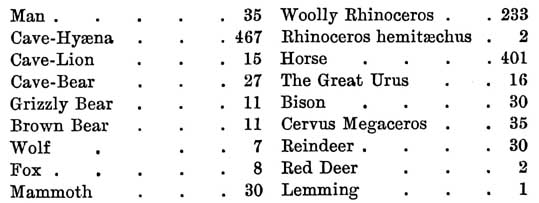

The upper soil. in the cavern 'yielded traces of Romano-British occupation, such as enamelled bronze fibula, fragments of pottery,' &c. 'In the surface soil and in the upper part of the Breccia (No. 2), there occur some bones of the domestic hog, goat, sheep, and Celtic shorthorn, but no implements of a Neolithic type were found associated with these.' Beneath this upper part,1. Stalagmite, 2 ft.
2. Breccia, with bones and flint implements, 1 ft. 6 in.
3. Cave-earth, with bones and implements, 1 ft.. 9 in.
4. Mottled bed, with bones and implements, 2 ft.
5. Red sand, with bones and quartzite implements.


1. Devonian Limestone.
2. Stalagmite.
3. Breccia.
4. Black bed.
5. Cave-earth.
6. Shingle.
v. Valley.